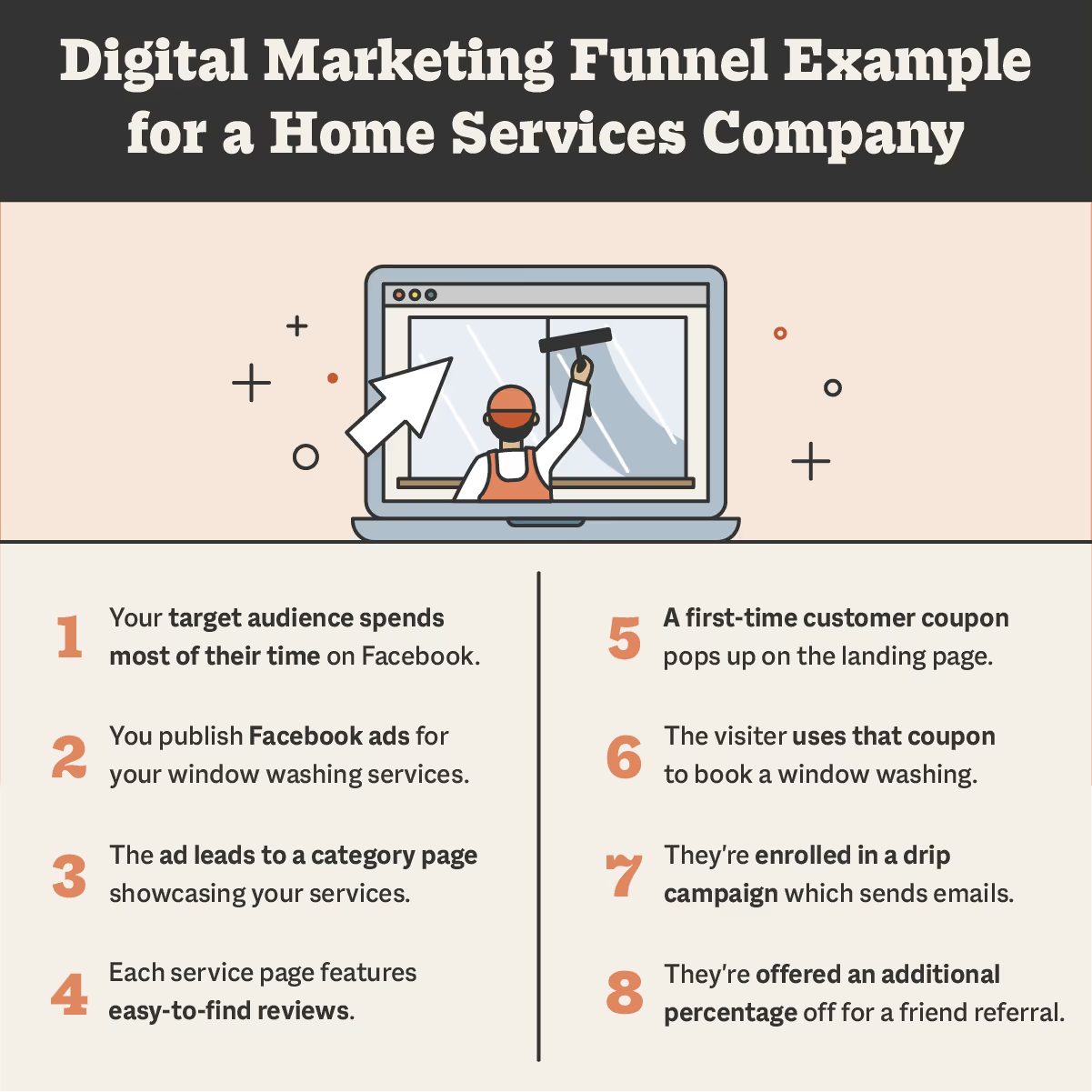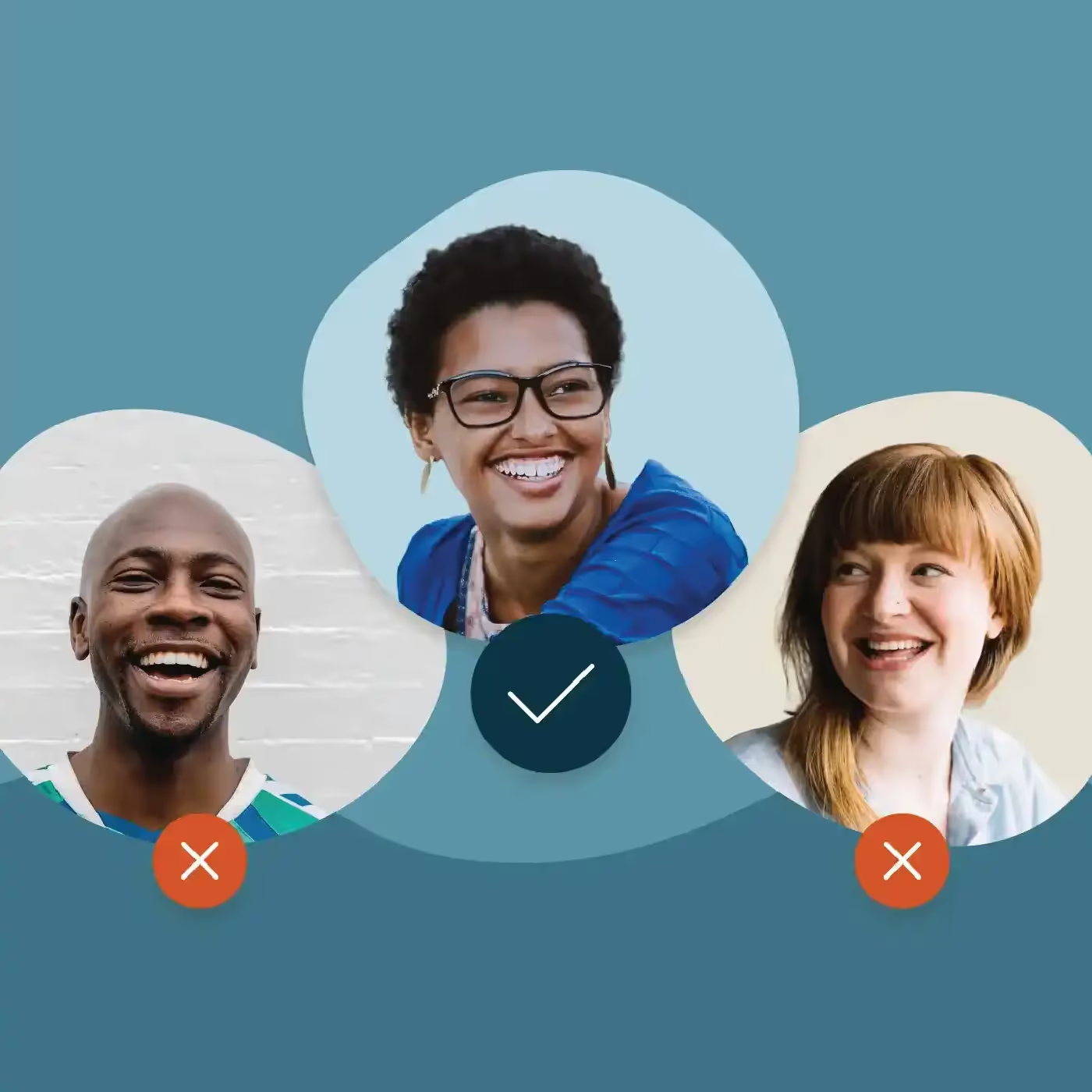Digital Marketing Funnel: Lead Nurturing for ROI
Digital Marketing Funnel: Lead Nurturing for ROI

An astounding 68% of businesses have not identified or measured their marketing and sales funnels. The digital marketing funnel and sales funnel are often mistaken as one process, however, the differences lie in what each department does to coach a lead to purchase and retain the relationship. By not prioritizing either funnel, these businesses are missing out on potential sales leads and revenue.
In this article, we’ll explain what the digital marketing funnel is and cover five steps for funnel optimization, so your team brings in more targeted leads to nurture throughout their journey.
What is the digital marketing funnel?
The digital marketing funnel is the framework used to convert website visitors into loyal customers.
The process starts when individuals are initially drawn to a business’s website through online ads, organic search, or referral sites. As visitors move through the funnel, they learn more about the brand through things like your website’s landing pages, blog, and customer reviews until they decide to make a purchase.
It’s important to note that not every visitor who arrives at a website starts at that brand’s first stage of the marketing and sales funnel. For example, a customer who is already aware of your brand and services may check out your website when deciding whether to work with you vs a competitor. This is known as the consideration stage.
Though the actual tasks within the marketing and sales funnel differ, they work hand-in-hand to achieve the same goal. The marketing funnel does the work to advertise a business and motivate leads to buy, whereas the sales funnel actually entices and works with leads through the buying process and ongoing relationships. Even so, digital marketers still aid in those later stages.

The six digital marketing funnel stages
Most modern digital marketing funnels can be broken down into the following six actionable stages — awareness, discovery, consideration, conversion, customer relationship, and retention.
1. Awareness
The first stage, awareness or also known as exposure, happens the very first time an individual comes across a brand online. This occurs through avenues such as organic search, social media, social or web ads, outreach, and more.
Businesses can gauge levels of brand awareness through KPIs like ad clicks, unique visitors, and search ranking improvements for unbranded keywords.
2. Discovery
The second stage — discovery — is when an individual’s interest piques after the initial exposure. In this phase, they begin to engage with a business’s website to learn more about the brand and may transition into qualified leads. Informative blog content and thorough landing pages are critical for this phase.
Important KPIs for the discovery stage are page depth, session duration, and lead magnet conversions.
3. Consideration
In the middle of the funnel is the consideration stage, otherwise known as desire. This is when individuals compare businesses to competitors — reading reviews to determine whether they should commit to one brand or another.
Bounce rates and backlinks — specifically those from third-party listings and review sites — may indicate how well a business’s consideration stage is executing.
Marketers should prioritize lead nurturing strategies in this part of the funnel to turn potential leads into customers who are ready to buy.
4. Conversion
The fourth stage — conversion — occurs when a lead makes a purchase, with traffic concentrated on checkout and contact pages. The speed at which a lead arrives at the conversion funnel depends on what the product or service is, its cost, and the urgency of the problem. This phase may also be referred to as the decision or action stage.
Some marketers conclude the digital marketing funnel after the digital marketing conversion, but it shouldn’t end here. The goal should be to foster repeat customers and brand loyalty.
5. Customer relationship
Maintaining a customer relationship is the next stage of the funnel, otherwise known as post-action. At this point, the goal is to learn everything there is to know about the buyer and prioritize customer support. In doing so, businesses can improve the customer experience, paving the way to the final part of the digital marketing funnel.
6. Retention & referrals
The goal of the retention phase is to reduce customer churn and create repeat customers. The previous stage — building the customer relationship — lays the foundation for retention.
Why is a digital marketing funnel important?
Companies that prioritize the customer experience and relationships have a 60% higher ROI than companies that don’t, and the digital marketing funnel plays into the overall customer experience.
The main benefit of a focused digital marketing funnel is that it aids in bringing in targeted, qualified leads and nurturing them into customers. In turn, this provides the opportunity to increase revenue through repeat customers. Instead of shooting in the dark and hindering your team’s productivity, you can reach your intended audience with a focused funnel.
How to create a successful digital marketing funnel
Now that you understand the importance of a digital marketing funnel, you’re ready to start planning and implementing your own. We’ve listed five tips below to help you get started.

1. Set your digital marketing goals and budget
Before creating or adjusting your digital marketing plan and funnel, it’s important to set your marketing goals. Get started doing so by taking a look at your business’s overarching goals — maybe it’s reaching a specific number of sales or new leads.
Each department of your business should have its own objectives and strategy for how to achieve bigger-picture goals. For the marketing team, that might look like doubling the business’s web traffic, and there are several avenues the team can take to reach that goal — from running paid advertisements to publishing content on LinkedIn to conducting a blog content audit. Your marketing goals lay the foundation for your team to perfect your digital marketing funnel.
It’s also important to determine your budget, as it allows you to allocate resources effectively and measure the ROI of your marketing efforts. Without a budget, it's easy to overspend on marketing activities that may not be generating enough leads or conversions.
A budget helps to prioritize and focus on the most effective marketing channels that are aligned with your business goals and target audience. It also helps to track spending and optimize the funnel by identifying areas for improvement and eliminating ineffective strategies.
2. Generate awareness and demand
Awareness is the first stage of the digital marketing funnel. If an individual isn’t aware of your brand, then they cannot be a customer. Boosting your brand’s visibility online might encompass:
- Featuring a purposeful “About Us” page with company details, history, team images, a valid business address, and contact information
- Consistently publishing targeted content on your blog that’s relevant to your target audience
- Creating business accounts on sites like Google My Business, Glassdoor, Yelp, etc.
- Actively posting on social media sites like Instagram, Facebook, Twitter, LinkedIn, YouTube, and Pinterest
These are examples of manageable activities a business can do for search engine optimization (SEO) — making a brand more visible to search engines like Google or Bing. When successful, your website should appear in search results when consumers key in phrases that relate to your brand. This, in turn, could boost traffic to your site and aid in lead generation.
Utilizing different marketing channels — like organic, paid search, and social media — can help you reach a wider audience to build brand awareness, leading to the discovery stage of the digital marketing funnel.
3. Create lead capture and nurturing mechanisms with conversion goals
With each part of the funnel, you want to nurture leads to coax them forward, ensuring they meet each stage’s conversion goals.
Creating targeted content for each funnel stage can aid in completed conversions. For example, visual media and videos tend to be successful at drawing attention to a business at the top of the funnel (TOFU) in the awareness and discovery stages. The main conversion here might be clicks to the business’s website from social media and paid ads.
For the middle of the funnel (MOFU) at the consideration stage, businesses should prioritize solution-based blog content, brand comparisons, and case studies. Some examples of MOFU conversions could be content downloads, live demos, or free trial sign-ups.
Finally, at the bottom of the funnel (BOFU) at the conversion and retention stages, if you’re still in the relationship-building phase, a conversion goal could be customer review views or subscribing to text alerts.
4. Qualify and engage leads
While you are nurturing your leads, you should gather information from them so that you can begin qualifying. That way, you’ll be able to pursue the leads that are the most worthwhile so you won’t waste your time on those that aren’t ready to buy at that time.
Additionally, you should develop a customer engagement strategy so that you can effectively communicate and interact with your leads and customers no matter where they are in the sales process.
For example, if you know that your target market is most prevalent on a certain social media platform, such as Facebook, then a TOFU engagement strategy would be actively engaging them on the platform and posting targeted Facebook ads.
5. Secure commitment and payment
The step of securing commitment and payment in the digital marketing funnel is the conversion stage. This is the stage where a potential customer has shown interest in the business and has taken an action that indicates their willingness to make a purchase or engage with the business in some way.
The conversion can take many forms, such as making a purchase, filling out a contact form, or subscribing to a newsletter. The goal of the conversion stage is to turn potential customers into paying customers.
Once a customer has converted, the business can continue to engage with them through follow-up communication, personalized content, and other customer engagement strategies.
6. Retain and upsell new customers
It’s important to keep the funnel going after the initial sale to encourage returning customers, increase upselling opportunities, and improve ROI.
The end goal of a digital marketing funnel is to foster customer relationships for those who return to make additional purchases. Ideally, your product or service convinces customers to come back on their own. However, your customers more than likely will need a push and that’s where a solid retention strategy comes into play.
Some examples of what to include in a retention plan are:
- Prioritize quick and thorough customer support by multiple means
- Set email drip campaigns to educate customers on how to use your product
- Send out email newsletters
- Offer loyalty programs or milestone coupons

Let Smith.ai nurture your leads through every stage of the funnel
You may find throughout this process that implementing a digital marketing funnel may be too much for your team to handle internally. Smith.ai’s virtual receptionists can serve as your inbound and outreach team, qualify leads for you, and help you nurture them through every stage of the funnel.
Let our team help optimize funnel stages to bring in more revenue for you. Book a consultation with Smith.ai today.
Take the faster path to growth. Get Smith.ai today.
Key Areas to Explore
Technical Implementation Terms
Voice user interface (VUl) design
Speech recognition integration
Text-to-speech optimization
API connectivity and webhooks
Real-time data synchronization

Your submission has been received!













.svg)



